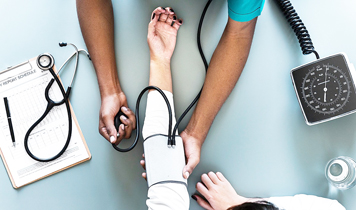 Cardiovascular disorders (CVD) are the leading cause of morbidity and mortality worldwide. CVD accounts for an estimated 17.5 million deaths annually, more than 75% of which occur in lower middle-income countries (LMIC). While the death rates due to CVD have declined in several high-income countries, the trend has not been the same in LMIC, South Asia (India, Pakistan, Bangladesh, Nepal, Sri Lanka), that represents one of the most densely populated regions in the world, experienced an increase of 73% in healthy life-years lost due to ischemic heart disease. Hypertension is a major contributor to cardiovascular morbidity and mortality worldwide and in India. There is a continuous relationship between the level of blood pressure and the risk of complications. The prevalence increases with age, from 13.7% in the 3rd decade to 64% in the 6th decade. The prevalence of hypertension varies in different regions of the country. This variation is due to social, economic, dietary differences in different parts of the country.
Cardiovascular disorders (CVD) are the leading cause of morbidity and mortality worldwide. CVD accounts for an estimated 17.5 million deaths annually, more than 75% of which occur in lower middle-income countries (LMIC). While the death rates due to CVD have declined in several high-income countries, the trend has not been the same in LMIC, South Asia (India, Pakistan, Bangladesh, Nepal, Sri Lanka), that represents one of the most densely populated regions in the world, experienced an increase of 73% in healthy life-years lost due to ischemic heart disease. Hypertension is a major contributor to cardiovascular morbidity and mortality worldwide and in India. There is a continuous relationship between the level of blood pressure and the risk of complications. The prevalence increases with age, from 13.7% in the 3rd decade to 64% in the 6th decade. The prevalence of hypertension varies in different regions of the country. This variation is due to social, economic, dietary differences in different parts of the country.
Types of Hypertension-
* Primary or Essential Hypertension- unknown aetiology.
*Secondary hypertension- with known cause, Mostly in younger(<30 years) age.
Measurement of Blood Pressure : Blood pressure measurement to be done with proper calibrated automated or aneroid sphygmomanometer. Use of Mercury sphygmomanometer to be avoid. Measurement to be done with proper cuff measurement, in proper position, with empty bladder, avoid any smoking and exercise 15-20 mint prior to measurement.
Blood pressure can be measure in office/clinic or at home by home blood pressure monitoring or by ambulatory blood pressure. Office blood pressure use to be for diagnosis of hypertension. Blood pressure above 140/90 mm of hg to be diagnosed as hypertension with at least 2 readings. Out of office blood pressure to be use for diagnosis of whitecoat hypertension and for follow up of patients who all are on antihypertensive drugs.
Symptoms and signs : Usually there is no specific symptoms or signs for hypertension. However, some patients came with upper abdominal pain, headache, nausea and vomiting. But patients can present with hypertensive complications for example due to long term uncontrolled blood pressure it can affect brain (CNS bleed), Heart (Acute Myocardial Infraction. Heart failure), kidney (proteinuria, generalized body, swelling, decrease urine output).
Management : The primary goal of therapy of hypertension should be to prevent, reverse or delay complications and thus reduce the overall risk without adversely affecting the quality of life. Treatment of hypertension depends upon grading if it is grade 1 then patients can be managed with lifestyle and dietary modifications and repeated blood to be monitored if controlled then continue same otherwise start them on antihypertensive drugs. In lifestyle patient should perform regular exercise (brisk walking) at least 150 mint per week or yoga and to avoid extra salt diet, avoid alcohol and smoking. If patients are in grade 2 or 3 along with lifestyle, dietary modification patients should start on drugs and monitor blood pressure. Sometimes blood pressure cannot be controlled with multiple drugs and with maximum dosage and we need to evaluate cause of secondary hypertension.
Precautions : along with dietary, lifestyle modifications and regular monitoring of blood pressure can prevent hypertension and related complications.
DO’s & DON’T FOR HYPERTENSION
* Do lifestyle modification with dietary modification to all adults especially above age of 40 years.
* Do regular blood pressure monitoring for adults who are above age of 40 yeas of age or below if any symptoms or complication of hypertension.
* Take regular medications.
* Regular check home based blood monitoring.
* Don’t avoid medications.
* Don’t lost follow up in OPD even blood pressure is in normal range.
* Don’t smoke, alcohol intake.
Facilities available at Dayanand Medical College & Hospital (DMC & H)
For Diagnosis- DMC & H have trained doctors and staff (in OPD and IPD) who can measure blood pressure along with proper guidelines which can help to make proper diagnosis and it can help to rule out false positive and false negatives.
For Treatment – DMC & H have trained and experienced doctors and paramedical staff who can manage hypertension on OPD basis and in emergency for management of hypertensive related emergencies. And for in-door patients DMC & H have trained and experienced staff and physiotherapists who can provide best nursing care and physiotherapy for management of patients who are admitted with complications of hypertension. At Hero DMC (a Unit of DMC & H) have 24×7-Hour working Cath lab with experienced doctors and staff who can provide primacy care specially for acute myocardial infarction- STEMI (complication of hypertension) with percutaneous interventions.
For Research- At Hero DMC a lot of research have already been done for hypertension and much more is going on. As they have researcher who are well trained.

